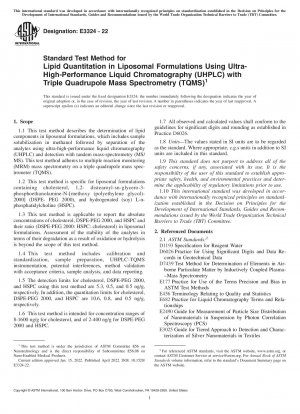ASTM E3324-22
Standard Test Method for Lipid Quantitation in Liposomal Formulations Using Ultra-High-Performance Liquid Chromatography (UHPLC) with Triple Quadrupole Mass Spectrometry (TQMS)
- Standard No.
- ASTM E3324-22
- Release Date
- 2022
- Published By
- American Society for Testing and Materials (ASTM)
- Latest
- ASTM E3324-22
- Scope
- 1.1 This test method describes the determination of lipid components in liposomal formulations, which includes sample solubilization in methanol followed by separation of the analytes using ultra-high-performance liquid chromatography (UHPLC) and detection with tandem mass-spectrometry (MS/ MS). This test method adheres to multiple reaction monitoring (MRM) mass spectrometry on a triple quadrupole mass spectrometer (TQMS). 1.2 This test method is specific for liposomal formulations containing cholesterol, 1,2distearoyl-sn-glycero-3phosphoethanolamine-N-[methoxy (polyethylene glycol)2000] (DSPEPEG 2000), and hydrogenated (soy) L-αphosphatidylcholine (HSPC). 1.3 This test method is applicable to report the absolute concentrations of cholesterol, DSPE-PEG 2000, and HSPC and their ratio (DSPE-PEG 2000: HSPC: cholesterol) in liposomal formulations. Assessment of the stability of the analytes in terms of their degradation as a result of oxidation or hydrolysis is beyond the scope of this test method. 1.4 This test method includes calibration and standardization, sample preparation, UHPLC-TQMS instrumentation, potential interferences, method validation with acceptance criteria, sample analysis, and data reporting. 1.5 The detection limits for cholesterol, DSPE-PEG 2000, and HSPC using this test method are 5.3, 0.5, and 0.5 ng/g, respectively. In addition, the quantitation limits for cholesterol, DSPE-PEG 2000, and HSPC are 10.6, 0.8, and 0.5 ng/g, respectively. 1.6 This test method is intended for concentration ranges of 8-1600 ng/g for cholesterol, and of 2-400 ng/g for DSPE-PEG 2000 and HSPC. 1.7 All observed and calculated values shall conform to the guidelines for significant digits and rounding as established in Practice D6026. 1.8 Units—The values stated in SI units are to be regarded as the standard. Where appropriate, c.g.s units in addition to SI units are included in this standard. 1.9 This standard does not purport to address all of the safety concerns, if any, associated with its use. It is the responsibility of the user of this standard to establish appropriate safety, health, and environmental practices and determine the applicability of regulatory limitations prior to use. 1.10 This international standard was developed in accordance with internationally recognized principles on standardization established in the Decision on Principles for the Development of International Standards, Guides and Recommendations issued by the World Trade Organization Technical Barriers to Trade (TBT) Committee.
ASTM E3324-22 Referenced Document
- ASTM D1193 Standard Specification for Reagent Water
- ASTM D6026 Standard Practice for Using Significant Digits in Geotechnical Data
- ASTM D7439 Standard Test Method for Determination of Elements in Airborne Particulate Matter by Inductively Coupled Plasma–Mass Spectrometry
- ASTM E177 Standard Practice for Use of the Terms Precision and Bias in ASTM Test Methods
- ASTM E2490 Standard Guide for Measurement of Particle Size Distribution of Nanomaterials in Suspension by Photon Correlation Spectroscopy (PCS)
- ASTM E3025 Standard Guide for Tiered Approach to Detection and Characterization of Silver Nanomaterials in Textiles*, 2022-11-15 Update
- ASTM E456 Standard Terminology for Relating to Quality and Statistics
- ASTM E682 Standard Practice for Liquid Chromatography Terms and Relationships
ASTM E3324-22 history
- 2022 ASTM E3324-22 Standard Test Method for Lipid Quantitation in Liposomal Formulations Using Ultra-High-Performance Liquid Chromatography (UHPLC) with Triple Quadrupole Mass Spectrometry (TQMS)
